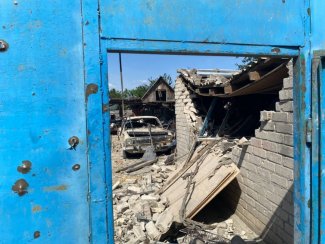Both sides hit back. Day 530 of the war

On the night of 5-6 August, the Russians launched an attack on airfields at Starokostiantyniv (Khmelnytskyi oblast), the main base for Ukraine’s Su-24M tactical bombers adapted to carry Storm Shadow/SCALP cruise missiles, and Dubno (Rivne oblast). In total, 70 drones and kamikaze missiles, including three Kinzhal hypersonic missiles, were used by the invaders in three waves. The Ukrainian Air Force Command reported that 17 out of 20 Kalibr missiles and 13 out of 20 Kh-101/Kh-555 missiles had been shot down, as well as all 27 Shahed-136/131 drones. In addition to the airfields’ infrastructure, a grain elevator in the area of Starokostiantyniv was also destroyed.
On 5 August, five enemy missiles struck Zaporizhzhia and nearby Komyshuvakha; the next day an unknown number of missiles from S-300 systems hit Kharkiv. On 7 August, the Russians targeted the region of Synelnykove in Dnipropetrovsk oblast, followed by Pokrovsk and the Kramatorsk area in Donetsk oblast. In Pokrovsk, the local interior ministry building was hit and destroyed. Most of the casualties were clerical staff and officers; by the morning of 8 August, the death toll had risen to seven and the number of wounded to 81. According to the Ukrainian General Staff, the enemy used a total of seven missiles that day, and the prosecutor’s office reported that Iskander missiles had been used to attack Pokrovsk.
On 6 August, the Ukrainians once again struck the Chonhar Bridge (a hit on its mid-section was confirmed) and the bridge over the Henichesk Strait, connecting Henichesk with the Arabat Spit (the surface was damaged and the gas pipeline supplying the city was set on fire). The occupation administration reported that the Chonhar Bridge would be closed to civilian traffic as of 8 August (after the attack on 22 June the repairs took two weeks, during which time a pontoon bridge was set up to enable traffic to cross over), and shuttle traffic was introduced on the bridge over the Henichesk Strait. The invaders reported the destruction of two out of four Storm Shadow missiles in the area of the Chonhar Bridge, and of nine out of 12 missiles (type not stated) in the area of Henichesk. On 6 August, the Russians also reported another failed attempt at a kamikaze drone attack on Moscow.
Late on the evening of 4 August, Ukrainian surface kamikaze drones attacked 30 miles south of the bridge over the Kerch Strait, and a small (6619 tonnes) local shipping tanker Sig was damaged. According to some sources, one of the drones hit a chain covering the approach to the bridge, over which traffic was temporarily halted. According to Marine Traffic monitoring reports collected by Interfax-Ukraine, the number of vessels approaching the Danube delta ports has fallen by a factor of 2 to 5 as a result of Russian attacks. The number of vessels at Izmail has dropped from 120 to 48, with a further 22 expected to arrive. At Reni, on the other hand, only 12 out of 58 vessels are still present, with a further 9 expected. Following Russia’s withdrawal from the Black Sea Grain Initiative, the so-called Greater Odesa ports have not yet resumed operation.
On 5 August, Russian forces seized Novoselivske in Luhansk oblast. For many months this location was the focus of the Ukrainian resistance south-east of Kupiansk. Over the next few days they also made advances east of this town, penetrating 3-4 km deep into enemy positions along a strip 11-12 km wide. The invaders’ progress was confirmed indirectly by the Ukrainian General Staff. Russian forces failed to push the Ukrainian defenders out of areas south-west of Bakhmut (although the invaders did cross the Donets-Donbas canal); successive Russian attacks in the vicinity of Avdiivka, Mariinka and Krasnohorivka, which lies north of it, also failed. By contrast, the situation in the area of the Russian bridgeheads on the west side of the Zherebets river and south-west of Kreminna has returned to a level of relative calm. There has also been no result of the Ukrainian attempts to advance north and south-west of Bakhmut, or south of Velyka Novosilka and Orikhiv. According to the Ukrainian General Staff, the invaders made an unsuccessful attempt to attack near Novopokrovka, south-east of the latter town.
On 7 August, Ukraine’s deputy defence minister Hanna Maliar summarised the past week’s activities, but did not provide any data on the Ukrainian army’s progress in the field for the first time since the offensive in the south began in June. Instead, she stated that “the Ukrainian Armed Forces have already broken through the first line of defence in some places, and are now encountering some difficulties on the next, intermediate line”. This report has not yet been confirmed. The defenders achieved some tactical success on the Mala Tokmachka-Robotyne axis; according to Maliar, the eastern section of the front was the centre of combat operations during the past week, with the heaviest fighting taking place in the area of Kupiansk.
On 8 August, Washington was to have announced another military aid package for Ukraine. It is worth $200 million and will include missiles for Patriot systems and Javelin launchers, GMLRS missiles for HIMARS launchers, other types of ammunition and demining equipment. On 4 August, the German Chancellery stated that Kyiv had received the previously promised two WiSENT 1 support vehicles with anti-mine ploughs (so far the Ukrainian army has received four vehicles of this type) and 11 anti-mine ploughs for T-72 tanks, as well as five SurveilSPIRE mobile reconnaissance systems and three Vector reconnaissance drones. On the same day, Lithuania announced a new support package with missiles for NASAMS systems and drones, and the Times of London reported that Britain would send Ukraine short-range anti-aircraft kits on a wheeled chassis (Supacat HMT 6x6) using AIM-132 ASRAAM air-to-air missiles.
The Belarusian 6th Mechanised Brigade began exercises on 7 August at the Hozha training ground and other areas in Hrodna oblast near the Polish-Lithuanian border. The Ministry of Defence in Minsk announced that during these exercises the Belarusian army would be taking advantage of Russian expertise acquired during the so-called special military operation, especially with regard to the co-operation between sub-units of different branches of troops, as well as the use of drones.
According to independent Belarusian media, on 7-8 August instructors from the Wagner Group conducted training at the training ground near Asipovichy with soldiers of the 51st Artillery Brigade, and near Hrodna with the 6th Mechanised Brigade. Currently, neither the Belarusian defence ministry nor the regime’s media have reported on the training or the mercenaries’ participation in it. On the other hand, the Ukrajinskyi Sprotyv website has reported that in recent days “another” plane with Wagner forces on board had left Belarus for Niger.
In recent days, Ukrainian law enforcement agencies have continued a widespread crackdown on officers from the Ukrainian army’s rear institutions suspected of corruption. Among the highest-ranking detainees was the head of a district-level recruitment centre for the city of Kyiv; he was accused of involvement in an organised criminal group which allegedly issued illegal documents confirming unfitness for military service. According to a statement from the State Bureau of Investigation (SBI), the accused was an accomplice of an officer serving on the staff of the Land Forces Command who had been arrested a few days earlier. Another form of abuse which has been reported is the illegal payment of combat allowances to soldiers who only served in the rear. On 8 August, the SBI said it had opened 112 investigations against employees of military recruitment structures since the start of the war; 15 such cases have already been referred to court.
On 6 August, the Ministry for the Reintegration of the Temporarily Occupied Territories of Ukraine announced that the Ukrainian-Russian border crossing point at Pokrovka-Kolotilovka (on the Sumy-Belgorod road) had resumed work. It can now be used by Ukrainian citizens residing in the occupied territories. According to a statement by the State Border Guard Service of Ukraine, the Russians had previously tolerated the passage of Ukrainians across the border with the Sumy region, sometimes even driving their own cars. In July this year, this option was at first severely restricted and then closed altogether, but at the beginning of August the Russians allowed Ukrainian citizens to cross the border again.
On 5-6 August, representatives of 42 countries met in Jeddah, Saudi Arabia, to discuss the ‘Ukrainian formula for peace’. In addition to representatives of Western countries, envoys from India, Egypt, South Africa, Brazil, China and the Gulf states also attended. The parties were mostly represented by advisors to leaders or heads or senior officials of foreign ministries. The Ukrainian delegation was headed by the chief of the President’s Office Andriy Yermak, the American delegation by presidential security advisor Jake Sullivan, and the Chinese delegation by special representative for Eurasia Li Hui. As expected, the talks did not end with any declarations. Summing up the summit on 7 August, Yermak said that the main conclusion of the meeting was to recognise the ‘Ukrainian peace formula’ as the most important benchmark for future peace talks.
Representatives of Russia were not invited to Jeddah. On 7 August Maria Zakharova, spokeswoman for the Russian foreign ministry, issued a statement stressing that Moscow would not recognise any peace talks in which it did not participate, and that it expects Kyiv to halt the hostilities. She added that Russian objectives remain unchanged: Ukraine is to become a neutral state with no access to nuclear weapons, and Kyiv should recognise the Luhansk, Donetsk, Zaporizhzhia and Kherson oblasts as part of Russia.
Commentary
- The Marine Traffic data confirms that the attacks carried out by the Russians in recent weeks on the handling and storage infrastructure in Ukrainian ports have significantly reduced the movement of vessels, and thus the export of grain products. It remains unclear how effective the Russian attacks on the Ukrainian army’s deepwater facilities have been. Following the disclosure on social media of the attack on Kyiv on 16 May, which resulted in damage to the Patriot system batteries, the local government in Kyiv has significantly toughened its treatment of people who publish data about the attacks, which has blocked the leakage of information about their course and effects with relative success. They now only publicise those attacks in which there are civilian casualties, and damage or destruction to civilian facilities alone.
- The Jeddah summit can be seen as a success for Kyiv. The aim of the meeting – like the previous one in Copenhagen this June, which had fewer attendees – was to try to consolidate various countries, including important non-Western players such as India, Brazil and South Africa, around President Volodymyr Zelensky’s so-called 10-point peace plan, which was first presented at the G20 summit in Bali last November. The plan’s demands include the restoration of Ukraine’s territorial integrity through the withdrawal of Russian troops (including from Crimea and the Donbas), holding the aggressor legally accountable, and obliging the Russian state to pay reparations. Kyiv intends to continue consultations in the Jeddah format until the end of the year; the ultimate aim is to bring about a summit at the level of heads of state & government to confirm the arrangements reached for each point in the plan.






